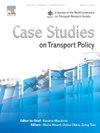Evaluating the operational and economic impact of the introduction of S-100 and e-Navigation within shipping companies
IF 2.4
Q3 TRANSPORTATION
引用次数: 0
Abstract
New navigational concepts and standards have recently emerged, including the International Maritime Organization’s (IMO) e-Navigation and the International Hydrographic Organization’s (IHO) S-100. These technologies have the potential to revolutionize shipping operations by enhancing efficiency and promoting environmental sustainability. A comprehensive study was conducted to assess the potential impact of e-Navigation on shipping companies, with a particular emphasis on the perspectives of Hydrographic Offices (HOs). The analysis is predicated on a survey that was conducted by HOs in 43 distinct countries. As they have accumulated a wealth of knowledge and experience in the development of S-100, HOs are uniquely positioned to evaluate the practical implications of these technologies. The S-100 framework was specifically examined as a case study within the broader context of e-Navigation in order to develop a more profound comprehension of its applications and impact. The insights obtained from this study can be used by policymakers to develop regulations and frameworks that facilitate the adoption of e-Navigation technologies, thereby guaranteeing the sustainable and efficient evolution of the maritime industry. The operational implications of navigational technologies are assessed in this study, which is a critical resource for policymakers, institutions, and shipping companies to inform future decision-making. Stakeholders can more effectively navigate the future of shipping operations by incorporating e-Navigation operational insights into maritime policy.
评估航运公司采用 S-100 和电子导航对运营和经济的影响
最近出现了新的导航概念和标准,包括国际海事组织(IMO)的电子导航和国际水文学组织(IHO)的 S-100。这些技术有可能通过提高效率和促进环境可持续性来彻底改变航运运营。为评估电子导航对航运公司的潜在影响,我们开展了一项综合研究,重点关注水文局(HOs)的观点。这项分析以 43 个不同国家的水文局进行的调查为基础。由于在 S-100 开发过程中积累了丰富的知识和经验,水文局在评估这些技术的实际影响方面具有得天独厚的优势。在电子导航的大背景下,我们将 S-100 框架作为一个案例进行了专门研究,以便更深入地了解其应用和影响。政策制定者可利用本研究获得的见解制定法规和框架,促进电子导航技术的采用,从而保证海运业的可持续和高效发展。本研究对导航技术的运营影响进行了评估,为政策制定者、机构和航运公司提供了重要资源,为未来决策提供了依据。利益相关者可以通过将电子导航的运营见解纳入海事政策,更有效地引导未来的航运运营。
本文章由计算机程序翻译,如有差异,请以英文原文为准。
求助全文
约1分钟内获得全文
求助全文

 求助内容:
求助内容: 应助结果提醒方式:
应助结果提醒方式:


